Patients with hormone receptor-positive (HR+)/HER2+ early breast cancer who were treated with neoadjuvant (presurgical) endocrine therapy or chemotherapy plus Herceptin (trastuzumab) and Perjeta (pertuzumab) (T+P) followed by adjuvant (postsurgical) pathological complete response (pCR; the disappearance of cancer)-guided chemotherapy and adjuvant T+P plus endocrine therapy experienced what researchers described as “exceptionally excellent” survival outcomes.
Findings from phase 2 WSG-TP II trial were presented at the 2024 ESMO Annual Congress.
Study Highlights
- Patients who achieved pathological complete response after neoadjuvant therapy followed by adjuvant T+P plus ET experienced exceptionally excellent survival outcomes
- Achieving pathological complete response was associated with significantly improved event-free survival and overall survival in the WSG-TP II trial.
- The addition of adjuvant chemotherapy after pathological complete response did not significantly improve survival outcomes in this trial.
- Clinically node-positive status was the only factor significantly associated with worse event-free survival in the analysis.
“In HR+, HER2+ disease, short 12 weeks de-escalated neoadjuvant treatment endocrine therapy or paclitaxel [chemotherapy], plus double blockade continued for one year offers a safe opportunity for chemotherapy de-escalation,” stated Dr. Oleg Gluz, of Breast Center Niederrhein in Mönchengladbach, Germany in a presentation of the study’s findings during the meeting.
LEARN MORE: Follow Along With Our Coverage of All The Major Findings Presented at the 2024 ESMO Annual Congress.
In the trial, 207 patients HR+/HER2+ EBC stages 1 to 3 were allocated to 12 weeks of neoadjuvant standard endocrine therapy (100 patients) versus paclitaxel chemotherapy (Pac) (107 patients) weekly plus T+P followed by standard endocrine therapy for a minimum of five years plus T+P for a year, with or without adjuvant chemotherapy.
The trial, Gluz said, is the first prospective survival comparison for endocrine therapy plus T+P compared with a chemotherapy-based regimen in HER2+/HR+ EBC.
In the endocrine therapy arm, the median patient age was 52 years, 63% of patients had stage 2 or higher disease and 68% were clinical node negative (cancer has not spread to the lymph nodes). In the chemotherapy arm, the median patient age was 54 years, 54% had stage 2 or higher disease and 76% were clinical node negative.
For patients who achieved pCR, the trial’s primary endpoint, omission of further adjuvant chemotherapy was recommended. Furthermore, secondary endpoints of the trial included event-free survival (EFS; the time a patient lives without experiencing complications from their cancer), and distant disease-free and overall survival (OS).
In the endocrine therapy arm, 29% of patients received no chemotherapy during the trial, and 60% of patients in the chemotherapy-containing arm received only 12 weeks of chemotherapy, Gluz said. Additionally, safety was superior in the endocrine therapy-containing arm and quality of life was maintained, he stated.
At a median follow-up of 60 months, the five-year EFS rates of endocrine therapy versus chemotherapy plus T+P were 92% versus 94.8%, with researchers, noting that of 13 EFS events, one versus four were distant relapses or deaths as the first event in the endocrine therapy versus chemotherapy arms. Additionally, five-year OS rates were 100% versus 97.9%, respectively.
Clinically node-positive status (cancer that has spread to the lymph nodes) was the only factor significantly associated with worse EFS by multivariable analysis, and additional chemotherapy after pCR was not associated with significant survival impact, researchers stated.
For more news on cancer updates, research and education, don’t forget to subscribe to CURE®’s newsletters here.





